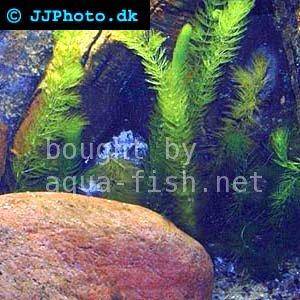Ceratophyllum demersum
Scientific name: Ceratophyllum demersum
Family: Ceratophyllaceae
Maximum size reached under cultivation: 10 - 80 cm (3.94 - 31.5 inch)
014
Recommended pH range: 6.2 - 7.5
Recommended water hardness: 4 - 18°dGH (71.43 - 321.43ppm)
0°C 32°F30°C 86°F
Recommended temperature range: 21 - 28 °C (69.8 - 82.4°F)
Preferred propagation method: Cuttings
Native to: Cosmopolitan
Growth rate: Fast
Recommended substrate: Gravel
Lighting requirements: Bright
Ideal placement in tank: Background
🌱 Common Name
Rigid Hornwort
🌍 Origin
Ceratophyllum demersum, commonly known as Rigid Hornwort, is an exceptionally adaptable aquatic plant with a global distribution. It thrives in a wide range of freshwater habitats, including lakes, rivers, ponds, and slow-moving streams. Found across North America, Europe, Asia, Africa, and Australia, its resilience makes it a popular choice for both aquariums and outdoor water gardens.
🏞️ Planting Area
Floating freely or background placement when loosely anchored. Ceratophyllum demersum naturally floats and lacks true roots, making it ideal for surface coverage or informal background planting. It can be gently secured between decorations or weighed down without burying it in the substrate, as burial may cause decay.
🌱 Propagation
Rigid Hornwort is extremely easy to propagate by taking cuttings from the stem. No special treatment is needed—simply float the cuttings in the aquarium, and they will continue growing. Although the plant does not develop true roots, it can entangle itself among decorations or in gravel, securing its position naturally over time.
💧 Water Parameters
- Recommended pH range: 6.2 - 7.5
- Recommended water hardness: 4 - 18°dGH (71.43 - 321.43 ppm)
- Recommended temperature range: 21 - 28°C (69.8 - 82.4°F)
⚙️ Difficulty
Easy
📝 Short Description
Rigid Hornwort is a fast-growing, undemanding aquatic plant suited for a variety of freshwater aquariums and ponds. It absorbs nutrients directly from the water column, making it particularly effective at removing excess nitrates and suppressing algae growth through allelopathic effects. Ideal for providing shelter to fish fry and shrimp, it also adds natural shading and a forest-like appearance when used as floating or background vegetation.
Its tolerance for different water conditions—including soft to hard water and a wide temperature range—makes it an excellent choice for both beginner and advanced aquarists. Rigid Hornwort is especially valued in low-maintenance community tanks, species-specific biotopes, and fry-rearing aquariums.



